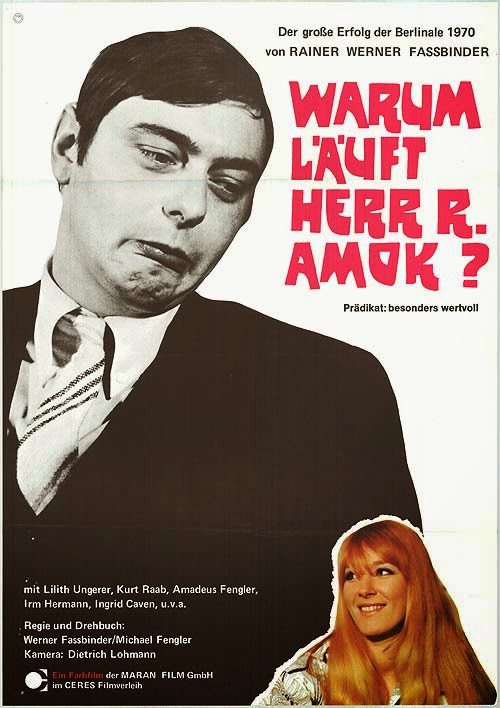Rainer Werner Fassbinder, 1973
Starring: Harry Baer, Marquard Bohm, Rudolf Waldemar Brem
Hanni, just fourteen, begins a relationship with Franz, a motorcycle-reading greaser who is 19 years old. She allows him to take her virginity, but he is soon arrested and imprisoned for a few months for having a sexual relationship with a minor. As soon as he gets out, they reunite, much to the horror of her conservative parents, particularly her father, who speaks increasingly of violence. Due to Hanni and Franz’s renewed relationship, she becomes pregnant, but they know no doctor will ever give her an abortion without arresting Franz again. But Hanni takes things into her own hands and develops a plan that will prevent her parents from interfering ever again.
Based on a play by Franz Xaver Kroetz, Kroetz initially worked with Fassbinder on the script, but hated the finished product because he thought it was too much like pornography. The German title, Wildwechsel, literally “Wild Game,” refers to the mating dance between the two teenagers, the chicken factory where Franz first works, and the farm location of their first sexual encounter. This blend of amour fou, sexual awakening, and Brechtian alienation affect is one of Fassbinder’s standard examinations of boredom, ennui, isolation, and the never-ending search for love. Similar in theme and style to Fassbinder’s earlier Pioneers in Ingolstadt (1971) and German playwright Franz Wedekind’s chilling Spring Awakening, what appears to be a family drama, even an after-school special at times, is really an attack against post-war bourgeois values.
The two teens, Hanni and Franz, are unable to communicate with each other and it seems completely impossible for them to express love or any other emotion. On the other hand, Fassbinder portrays the parents as affectionate towards each other, yet falling apart because they are losing control of their child. Though this seems highly domesticated, it also has numerous political elements. The parents discuss the government, stating that while the Nazis were wrong, the current government doesn’t have it right either. Out of his anger and digust, Hanni’s father that says that under Hitler, Franz would have learned his lesson in a concentration camp and that he would prefer a government that gassed Jews, as long as they took care of the pig that seduced his daughter.
The violence of thought, speech, and eventually deed is related to the air of repression and claustrophobia that settles over the film. Hanni does appear to be childlike with her dresses, braided hair, dolls on her bed, a preference for soda rather than beer, and a scene where she plays hopscotch, but this is perhaps out of proportion with her parents need to control her feelings and her behavior. Her family home — as well as other buildings and offices shown in the film — are adorned with crosses and religious imagery, showing that this form of moral control is expressed throughout the society they live in. Along with Pioneers in Ingoldstadt, this is one of Fassbinder’s most unlikable films. Both are more visually realist, simpler than his stark early works or ornate later films. And both deal with the struggles of lower middle class characters to either break out of social norms or make enough money to live up to them.
SPOILERS. Based on a real-life case from the 1960s, the ending prefigures Peter Jackson’s Heavenly Creatures, another film based on a real-life tale of teens who murder a parent when they are prevented from being together. But like so much of Fassbinder’s work, the horror present here is less in the moment of death than it is in the constantly frustrated scenes of living, or trying to live. Eva Mattes was not one of his regular cast of actresses, but performs admirably in the role of Hanni, where her rounded face and childlike demeanor belies the fact that she is clearly not a 14 year old. She is also either the seducer, or at least a more than willing participant. Fassbinder’s frequent collaborator Harry Baer (Gods of the Plague) looks youthful, but defeated, as if life (or Hanni) has led him down a path not of his own choosing. Regardless, as with many of Baer’s other characters, he refuses to act or to save himself from a certain doom brought by love — or at least sex.
WIldwechsel is not available on DVD, but you can hunt it down online with some searching. It only comes recommended for fans of Fassbinder or anyone interested in seeing a companion piece of sorts to Heavenly Creatures, a look flattened out look at the battle between teen counterculture and conservative working class values. It is still a worthwhile look at the still-developing career of one of cinema’s geniuses. The soundtrack -- a blend of ironically-used romantic '60s pop songs with classical themes better suited to high melodrama -- is a clear example of this transformation and is one of the finest things about the film.















